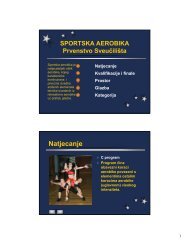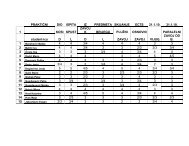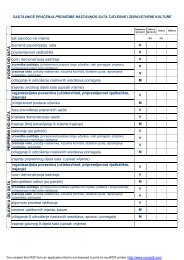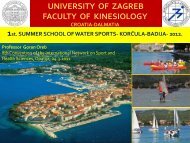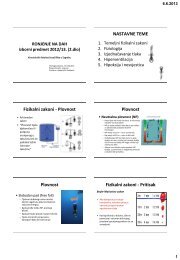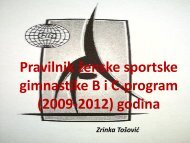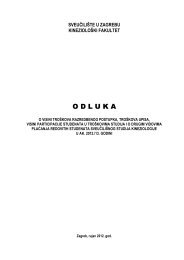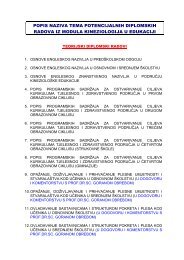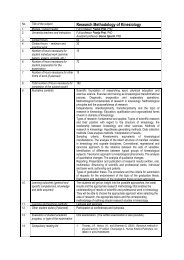The Journal of P hysiology Physiological adaptations to low-volume ...
The Journal of P hysiology Physiological adaptations to low-volume ...
The Journal of P hysiology Physiological adaptations to low-volume ...
Create successful ePaper yourself
Turn your PDF publications into a flip-book with our unique Google optimized e-Paper software.
1080 M. J. Gibala and others J Physiol 590.5<br />
also be involved (Gibala et al. 2009; Little et al. 2011b).<br />
Elevated levels <strong>of</strong> PGC-1 protein also accompany increased<br />
markers <strong>of</strong> mi<strong>to</strong>chondrial content fol<strong>low</strong>ing a period<br />
<strong>of</strong> <strong>low</strong>-<strong>volume</strong> HIT. Six weeks <strong>of</strong> Wingate-based HIT<br />
increased the protein content <strong>of</strong> PGC-1 by ∼100% in<br />
young, healthy individuals (Burgomaster et al. 2008)<br />
and 2 weeks <strong>of</strong> 10 × 1 min HIT resulted in a ∼25%<br />
increase in nuclear PGC-1 protein (Little et al. 2010b).<br />
Collectively, these results indicate that PGC-1α is probably<br />
involved in regulating some <strong>of</strong> the metabolic <strong>adaptations</strong><br />
<strong>to</strong> <strong>low</strong>-<strong>volume</strong> HIT. Given the positive effects that a modest<br />
increase in muscle PGC-1α appears <strong>to</strong> have on oxidative<br />
capacity, anti-oxidant defence, glucose uptake, resistance<br />
<strong>to</strong> age-related sarcopenia and anti-inflamma<strong>to</strong>ry pathways<br />
(Sandri et al. 2006; Ben<strong>to</strong>n et al. 2008; Wenz et al. 2009),<br />
the increase in PGC-1α fol<strong>low</strong>ing <strong>low</strong>-<strong>volume</strong> HIT may<br />
highlight potential widespread health benefits for this type<br />
<strong>of</strong> exercise.<br />
<strong>The</strong> impact <strong>of</strong> interval types <strong>of</strong> training programs<br />
on cardiovascular structure and function has also been<br />
investigated (Wisl<strong>of</strong>f et al. 2009), but few studies have<br />
utilized <strong>low</strong>-<strong>volume</strong> HIT models. However, as little as<br />
2 weeks <strong>of</strong> Wingate-based HIT has been reported <strong>to</strong><br />
increase cardiorespira<strong>to</strong>ry capacity as reflected by changes<br />
in peak oxygen uptake ( ˙V O2 peak) (Whyte et al. 2010)<br />
although this is not a universal finding (Burgomaster<br />
et al. 2005). Another study showed that 6 weeks <strong>of</strong><br />
Wingate-based HIT increased ˙V O2 peak <strong>to</strong> the same extent<br />
as traditional endurance training despite a markedly<br />
reduced time commitment and <strong>to</strong>tal training <strong>volume</strong><br />
(Burgomaster et al. 2008). We have also shown in<br />
young healthy men and women that <strong>low</strong>-<strong>volume</strong> HIT<br />
increases compliance in peripheral but not central<br />
arteries (Rakobowchuk et al. 2008). <strong>The</strong> pro<strong>to</strong>col also<br />
Figure 3. <strong>The</strong> effect <strong>of</strong> varying the intensity <strong>of</strong> interval<br />
training on changes in 40 km time-trial performance<br />
Well-trained male cyclists were randomly assigned <strong>to</strong> one <strong>of</strong> five<br />
different doses <strong>of</strong> high-intensity interval training (HIT): 12 × 30 s at<br />
175% <strong>of</strong> peak sustained power output (PPO), 12 × 1 min s at 100%<br />
PPO, 12 × 2 min at 90% PPO, 8 × 4 min at 85% PPO, or 4 × 8min<br />
at 80% PPO. Cyclists completed six HIT sessions over a 3 week<br />
period in addition <strong>to</strong> their habitual aerobic base training. Redrawn<br />
from Step<strong>to</strong> et al. (1999) with permission.<br />
increased endothelial function in the trained legs <strong>to</strong> an<br />
extent that is comparable <strong>to</strong> changes observed after a<br />
much higher <strong>volume</strong> <strong>of</strong> continuous moderate-intensity<br />
training (Rakobowchuk et al. 2008). <strong>The</strong> mechanisms<br />
regulating cardiovascular <strong>adaptations</strong> <strong>to</strong> various forms<br />
<strong>of</strong> <strong>low</strong>-<strong>volume</strong> HIT have yet <strong>to</strong> be comprehensively<br />
examined.<br />
Potential application <strong>of</strong> HIT in people with or at risk<br />
for cardiometabolic disorders<br />
While much <strong>of</strong> the work conducted <strong>to</strong> date has involved<br />
relatively high-<strong>volume</strong> pro<strong>to</strong>cols that are comparable in<br />
<strong>volume</strong> <strong>to</strong> traditional endurance training, HIT has been<br />
shown <strong>to</strong> improve cardiorespira<strong>to</strong>ry fitness in a range <strong>of</strong><br />
populations including those with coronary artery disease,<br />
congestive heart failure, middle age adults with metabolic<br />
syndrome and obese individuals (Warbur<strong>to</strong>n et al. 2005;<br />
Wisl<strong>of</strong>f et al. 2007; Moholdt et al. 2009; Munk et al.<br />
2009). In many cases, the increase in cardiorespira<strong>to</strong>ry<br />
fitness after HIT was superior <strong>to</strong> after continuous<br />
moderate-intensity training (Wisl<strong>of</strong>f et al. 2007; Tjonna et<br />
al. 2008, 2009; Moholdt et al. 2009). Endothelial function,<br />
assessed using f<strong>low</strong>-mediated dilatation <strong>of</strong> the brachial<br />
artery, is improved <strong>to</strong> a greater extent fol<strong>low</strong>ing HIT<br />
compared with continuous moderate-intensity training<br />
(Wisl<strong>of</strong>f et al. 2007; Tjonna et al. 2008, 2009; Moholdt<br />
et al. 2009). Other studies have documented beneficial<br />
changes in various components <strong>of</strong> resting blood pressure<br />
(Rognmo et al. 2004; Schjerve et al. 2008; Whyte et al. 2010)<br />
and left ventricular morphology (Wisl<strong>of</strong>f et al. 2007). It<br />
appears that this type <strong>of</strong> cardiac remodelling requires a<br />
longer duration <strong>of</strong> training and greater exercise <strong>volume</strong><br />
than the load required <strong>to</strong> alter cardiorespira<strong>to</strong>ry fitness<br />
or peripheral vascular structure and function. It could be<br />
that the short intense bursts <strong>of</strong> activity with <strong>low</strong>-<strong>volume</strong><br />
HIT induce large-magnitude increases in cellular and peripheral<br />
vascular stress, while effectively ‘insulating’ the<br />
heart from those stresses due <strong>to</strong> the brief duration <strong>of</strong><br />
the exercise bouts. This relative central insulation permits<br />
individuals <strong>to</strong> train at much higher intensities than they<br />
would otherwise, but may also result in different timelines<br />
and effective stimulus loads between the central and peripheral<br />
components <strong>of</strong> the cardiovascular system.<br />
Low-<strong>volume</strong> HIT studies in persons who might be<br />
at risk for cardiometabolic disorders or patients with<br />
chronic disease are very limited. However, recent work has<br />
shown that as few as six sessions <strong>of</strong> either Wingate-based<br />
HIT and the more practical constant-load model over<br />
2 weeks improve estimated insulin sensitivity in previously<br />
sedentary, overweight individuals (Whyte et al. 2010;<br />
Hood et al. 2011). Insulin sensitivity in these studies<br />
was calculated based on either single fasting glucose<br />
and insulin measurements (Hood et al. 2011) or the<br />
C○ 2012 <strong>The</strong> Authors. <strong>The</strong> <strong>Journal</strong> P<strong>hysiology</strong> C○ 2012 <strong>The</strong> <strong>Physiological</strong> Society<br />
Downloaded from J Physiol (jp.physoc.org) by guest on March 21, 2012




![NASTAVNI_PLAN_I_PROGRAM-_integrirani_studij [2,09 MiB]](https://img.yumpu.com/23830973/1/184x260/nastavni-plan-i-program-integrirani-studij-209-mib.jpg?quality=85)
